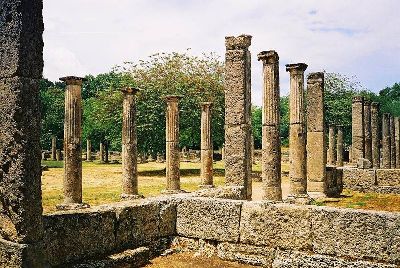History of the Olympics: The Ancient Olympic Games
The Olympics had their beginnings on the western side of the Greek Peloponnesus,in the wooded plains of Olympia in Elis. Formally started in 776 B.C., the Games initially featured but one event – a 200-meter dash known as the stadium. This continued for 52 years, and then a two-stade race (400 meters) was added, called the diaulos. For the following Olympiad a third event, the dolichos, required runners to compete for up to 24 times the length of the original stadium.
In 708 B.C. the Olympics became more greatly diversified as the pentathlon was introduced, featuring not justrunning but also wrestling, jumping, and throwing the discus and javelin. More events followed in later years: boxing in 688 B.C.; a four-horse chariot race eight years later; horse racing as well as the pankration, a primitive martial art, added in 648 B.C.; a footrace in heavy armor included over a century later; and finally, a two-horse chariot race begun in the year 408 B.C.
Some interesting rules and customs surrounded the ancient Olympics. For instance, married women were not permitted to watch, let alone participate in, the Games. Even the threat of capital punishment, however, did not stop some from disguising themselves as men in order to attend the festivities. While no woman was allowed to compete, some nonetheless had special honors bestowed upon them, such as the priestess of Demeter, goddess of fertility, who had a revered place near the Stadium altar; and Kyniska of Sparta, the first female victor in an Olympic event, proclaimed as such because her ownership of the horses, and not the horsemanship of the chariot driver, granted her the right to the title.
Other rules dealt with a strict truce that always came into effect around the time of each Olympiad. From the very beginning in 776 B.C., when the city-states Elis and Pisa established a treaty and subsequently formalized the Olympics as a festival to be celebrated every four years, peace and safety were honored as a means to gather peoples from various regions in a spirit of toleration and friendship. Messengers would be sent to announce the truce and the time when the Olympics would be held. Any hostilities would be put on hold for a month—later the period was extended to three months—so that all travelers, including athletes, artists, spectators, and their families, might journey to and from the Games without fear. In addition, no armies or armed individuals could gain entry to the Olympic sanctuary, as it was indeed regarded.
The ancient Greeks prized competition as a superb means of self-improvement. Regardless of class, all free male Greek citizens were eligible to participate in the Olympics, and they vigorously took advantage of this opportunity to better themselves mentally and physically before each Olympiad, hoping they might gain honor for their prowess during the glorious event. Nothing could deter them from the chance to be named the best. Even when, for example, the threat of facial disfigurement by hard leather straps worn on the hands in boxing was increased to a risk of death by Roman-designed spikes and lead weights, there were always competitors hungry to undergo the athletic challenge.
Self-development and peace, friendly competition and diversity of skill and culture—these were at the heart of the ancient Olympic Games. It is no wonder that their modern counterpart holds such appeal for people now. Today’s Olympics give us a chance to carry on the noble legacy of essential values left to us by our ancient forebears.
History of Ancient Olympics
History of Modern Olympics
Highlights from the Modern Olympics Winter Games
Highlights from the Modern Olympics Summer Games

